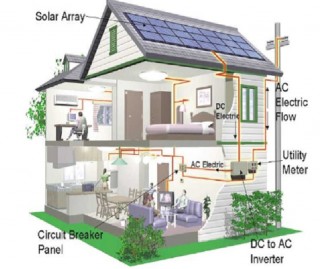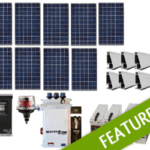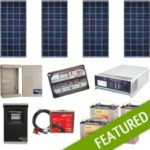240W Grid-Tied Residential Packaged System
$3,259.00
Description
240W Grid-Tied
Residential Packaged System
PARTS LIST AVAILABLE UPON SALE
Solar Panel Package – Utility Grid Tied for the Energy-Efficient Residential Home
240W Peak Watts DC Solar Panel System Featuring 4 Kaneka 60W Solar Panels
Description
This a grid-tied system for a residential energy-efficient home. The output of this system varies depending upon where you live and what time of the year it is. Use the map at the bottom of the page to get an idea of how many Watt*Hours you can expect from your system on average during a typical year. Expect more ouput in the summer (highest output period) and less in the winter (lowest output period).
Components:
1. Photovoltaic Modules (aka solar panels, solar electric panels)
The PV modules are the individual building blocks for providing power from the sun. They are typically made from silicon cells, glass, tedlar, and aluminum. PV modules can vary in type, size, shape, and color. The common nominal voltages for modules are 12V and 24V, but newer modules that are intended for grid tie systems, often now have much higher voltages to accommodate the voltage windows of grid tie inverters. Costs for PV modules are currently ranging between $4.40 and $5.40 USD per rated watt.
2. Racking/Mounting System for PV modules
The mounting system for the PV modules includes the hardware to permanently affix the array to either a roof, a pole, or the ground. These systems are typically made of aluminum and are customized to the mounting surface and the model of module used. It is important to consider distance from roof for flush-type roof mount installations. Restricting airflow under the modules results in higher module operating temperatures that reduce power output. With pole mounts wind loading must be considered and proper civil works must be done with the foundation for the pole as well as the possible addition of supplementary wind supports for the array frame. The cost of a mounting system can vary drastically based upon the number of modules and type of mount. The average cost is between $250 and $1000 USD.
3. Combiner Box
A combiner box is an electrical box where series strings of PV modules are then spliced in parallel. This is also the place where the PV series string fuses or circuit breakers are located. This allows the installer to bring the separate strings together and combine them into one positive and one negative conductor, change wire types and leave the area of the modules in conduit. They are usually outside and weather rated, so they can be right next to the array. Combiner boxes usually cost between $80 and $140 USD.
4. DC and AC Disconnects
The DC and AC disconnects are manual switch units that are capable of cutting off power to and from the inverter. Some inverters have disconnects integrated into the unit with switches, others can have them integrated into a power panel assembly, and some inverters leave you on your own to provide suitable disconnecting means. The disconnects are used by service personnel or authorized persons (fire/police/electric workers) to disable power from a renewable energy system (in this case PV) so that there are no live electrical parts associated with the inverter, and that no current is going to the grid that could harm utility employees in the event that they are working in your area. Homeowners or authorized personnel can use the disconnects to de-energize a system for maintenance or service. Disconnects can range in cost from $100 to $300 USD.
5. Grid Tie Inverter
The grid tie inverter is the device that takes the energy that the photovoltaic system produces in DC current form and turns it to AC current that is then sent (sold) to the electric grid. These inverters typically have a voltage input range from 100 to 500 volts DC and they convert it into 120 volts AC, 240 volts AC, or 208 volts AC. These inverters are especially sophisticated devices that must conform to special regulations in order to tie into the utility. When the power goes out in your area, it is important to know that the grid tie inverter will not allow power to be sold back to the grid. This is done to prevent electric utility workers from being injured or killed by working on power lines they thought were de-energized. When the power goes out, your power will go out as well. A grid tie inverter will not resume normal operations until the utility grid has established standard conditions for 5 straight minutes within strict parameters. Prices for inverters can range from $1400 to $4000 USD.









Reviews
There are no reviews yet.